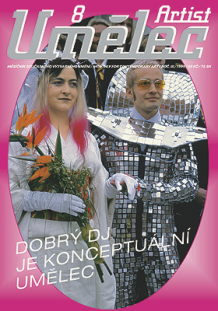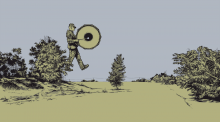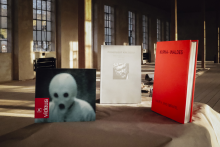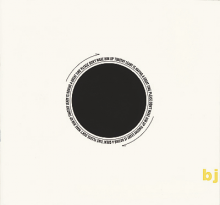| Revista Umělec 2000/6 >> Looking Within An interview with Milena Kalinovská | Lista de todas las ediciones | ||||||||||||
|
|||||||||||||
Looking Within An interview with Milena KalinovskáRevista Umělec 2000/601.06.2000 Lenka Lindaurová | q&a | en cs |
|||||||||||||
|
"Milena Kalinovská is an independent curator at the ICI institute (Independent Curators International) in New York. Before that she worked as the director of the Institute of Contemporary Art in Boston where she curated Boston School, New Histories, Bill Viola, and Rachel Whiteread and focused on presenting Czech artists in a Western context. She emigrated to London in 1970 where she organized exhibitions for the Riverside Studio (Richard Prince, Richard Deacon, Magdalena Jetelová). She has prepared the exhibition Beyond Preconceptions — The Sixties Experiment for the ICI as a traveling exhibition that premieres in Prague and will go on to Warsaw, Buenos Aires, Sao Paulo and San Francisco.
You come from the Czech Republic, and although you didn’t have a chance to return you communicated with the country through art. I was wondering what your impressions are of contemporary Czech art from the past 20 or 30 years, and which works you have had a chance to present outside the country? I was intrigued by a number of Czech art works and in fact the entire time I was living abroad they inspired me in several ways. I tried to look at the works as they were, but I couldn’t help seeing them in an international context. I’ve always looked for something purely individual in them, something that comes from this environment, something that is characteristic and can work abroad at the same time. When this kind of work appears in a different environment, you may understand it, but it is at the same time completely different from what you’ve seen before. I’ve recently been interested in women artists that I’ve never worked with, like Veronika Bromová or Kateřina Vincourová. I felt their works could stand up to the test of international standards. Going back deeper into history, I first came to Prague in 1990 and somebody told me to go and look at an exhibition at U Hybernů of students from the Fine Arts Academy. It was a big exhibition. I went there with one thing in mind: to present somebody in Boston. Milena Dopitová’s work there really surprised me. I remember it to this day. She showed a very simply produced black-and-white photograph of twins on cheap paper. In front of it, she placed an embroidered table with two chairs and nearby something like a bedside table. I was really stunned. Photographs by Struth and other artists concerned with identity were being shown at that time. But they were excessive perfectionists. What I saw here was something with a special atmosphere — something like Czech modernism, but at the same time it was provocative, emotionally feminine. And nobody was doing embroidery at that time. I instantly decided that I wanted to meet this artist and show this particular work. It was a bit risky because I had yet to see anything else by her. I was told that Milena Dopitová was still at the academy and that she wasn’t ready for an exhibition. I went back to the US and, without seeing any of her other works, I invited her for residency. Colleagues at the ICI in Boston naturally questioned me but I insisted that we had found somebody new who hadn’t been presented yet, that we were responsible for helping artists, giving them a chance, and that in her I saw great potential. Milena has since become very popular. Many critics and theorists were very interested in her. She took part in an exhibition of women working in a Boston context, and in a discussion about the position of women in artistic and human contexts. She also showed at the Ronald Feldman Gallery in New York. If you wanted to exhibit somebody from this country now, who would it be? I saw a very interesting installation at the Golden Ring House (City Gallery Prague). Petr Pastrňák projected slides and played music from the 1960s. The installation addressed family, and intimate space. It was simply rendered and to me it seemed accessible. So he could be another one. I’m not going to talk about painters. I met with Jiří David and Jiří Kovanda, who were interesting in the context of painting in the 1980s. But they were not exactly what I was searching for. From the older generation, I showed Magdalena Jetelová and I’d like to work with her on her retrospective. I think also there might be some interesting architecture here. I’ve had the opportunity to meet Josef Pleskot. From the catalogues and from cooperating with him I feel that I’d like to have a look at some of the architecture that’s happening. I think he’s an exceptional person; there aren’t many like him in architecture. I also looked at some other architects who are recognized and I have to agree with you. I get a completely different feeling from him — his approach to things, the way he thinks. I feel a little guilty about Slovak art because Slovakia probably has some interesting work that I just don’t have good access to. I know Mlynarčík and Filko and I think that a small exhibition of the two individuals could be very provocative in the North American and even Czech settings. But what I’d really like to do now is video. When you were selecting Czech artists for the exhibition Beyond Preconceptions at Veletržní Palác, were you looking for someone who would fit the exhibition’s concept or did you simply pick your favorite artists? The interesting thing was that I’d never worked with Karel Malich before. I prepared a much longer list of people but I won’t talk about that because it would be unfair. My co-curators, the Ševčíks, also made their selection. I surprised myself by selecting Malich, but I’m glad because he’s precisely as unpredictable as I imagined the exhibition would be. I hope we took Malich a step further and that he will now show at exhibitions in the US. I think his work is inspiring for contemporary art. Maybe I came to him through contemporary art rather than the 1960s. I consider Jiří Kolář a crucial figure of that period. I don’t know what I would do if I told myself that I could only select one artist. I would perhaps end up showing Karel Malich anyway to get away from already proven figures and open up something less well known for a different audience. The problem here in the Czech Republic is that the territory is small and there are very few truly good artists and their works just rotate from exhibition to exhibition. A Czech viewer already knows which five or ten artists of the older generation are automatically included if you, for example, explore the 1960s. Malich would be much more interesting for America. Definitely, it will come as a complete surprise to North and South America because Malich’s name has never actually appeared there. But, similarly, works by South American artists, such as Oiticica, Clark, Maiolina, are new in Prague and even in North America. How did you come across such “exotic” artists? I worked as a coordinator on a traveling exhibition called Inside in Visible. It wasn’t my exhibition. It was concerned with women in the 1920s, 1960s and 1990s. It was then that I saw Lygia Clark and Maiolina for the first time and got to know their work. Curators in the US more or less know their names but on a theoretical level rather than from any exhibitions. When we were selecting Clark and Oiticica, it was as much a given as making a selection from the few well-known names here. We could have taken people from the periphery but that wouldn’t be responsible in a situation where even the more important ones are not known outside their own context. I even toyed with the idea of putting together an exhibition of unknown artists from Europe, the USA and South America. But I didn’t think it was fair to Eastern Europe and South America because even lesser known artists from the USA had long been discovered within their contexts. So I went back to the original concept, which I thought was conservative. Sol LeWitt and Weiner are no discoveries, but I have to say that I got a fresh look at those classics thanks to Clark and Krasiński. If I had to do this in the US, I would perhaps conceive it differently. I would look for some correlations. But in this particular context, these specific works that I didn’t know addressed me and excited me. Artists of the 1960s experimented significantly and your exhibitions show the gradual dematerialization of art and the roots of the concept. Artists started using non-artistic materials. They attempted to surpass the esthetics of modernism. Looking at their work today, their experiments feel esthetic anyway. I don’t think you can really put yourself into that period — you can’t perfectly grasp it. The only possibility is to appreciate what they had to overcome at that time, before they could look at it from our perspective. That’s why it is crucial to know the dilemmas of the time, and we might be surprised. But to do so we would have to put ourselves into the closest possible contact with the artists and their works. I mean really put on Lygia Clark’s suit; run with Krasiński in the streets throwing blue cords on the ground; we’d have to sit at a table with Lawrence Weiner and get into a heated argument with him. And then it would have to be different, because, in the end, everything looks different in a museum or a gallery. What should the meaning of such institutions be then? There are a number of discussions about that today. On the one hand, it’s said that museums should address as many viewers as possible — that art is for everybody. On the other, we exhibit problematic pieces so that everybody can see them and then try to show mediocre works so that viewers can feel good. But I think we underestimate viewers. The situation here is a bit more complicated. Viewers don’t have any experience with the interpretation of art after so many years of isolation, and that’s why they think art is inaccessible. They actually fear art. On the other hand, the youngest artists don’t react to older works because they don’t have any reference to a past they know nothing about. If they came across works in a studio or in person, they would respond to them, but in a gallery they find them cold and dead. They should try and communicate with them. Some works are incredibly lively, like for example objects by Beta Goodwin, who uses pubic hair. Another thing is respect. Everybody will one day belong to a past generation. Every person, whether in political life or elsewhere, has made a huge effort to push things ahead. I was really surprised by Mangelos, whom I discovered two years ago. A philosopher and member of the Gorgona art group, he had been writing down stories about his friends in black notebooks ever since he was a child. He then blacked out or whited out certain parts of the text as they began dying in World War II. I felt that this was not the production of a contemporary artist trying to get into the best galleries but that these were things he had really experienced — it’s absolutely authentic. When you get involved in something, it becomes your life. Is it really possible to get that involved in art in today’s consumer society? In the end, doesn’t it make the artist feel a little ridiculous? Tragic situations like that do happen today. There are artists who make something from themselves, such as Nan Goldin. Mark Morrisroe did it before her, but paradoxically she got the most attention. Museums now fight for her. But such times always pass. In five, ten years the artists will have to draw on something again. It’s very dangerous and is also a concern for us curators and historians. I’m just saying that one has to take things with humility, including success. You may be successful, catch a wave and ride it out, but at a certain point it collapses because you can’t always be the most topical thing around. It is then necessary to look inward and search again for who you really are — but this isn’t really talked about that much. Can you tell this from an artist’s work? I think so, if you know the person well. When I look at Mark, I know it. Out of everyone, for me, he’s the biggest photographer. He never followed a method that he didn’t try to apply in a speculative way. Let’s not forget, though, that he died young. Do you think that contemporary art can be socially and politically engaged? I think that art is, on the contrary, turning away from this. It is more concerned with how to make a viewer penetrate art. But there could be traces of this kind of engagement in the subtext. Engagement is pretty open in the works of artists who are concerned with racial issues. Glen Leigon has helped subvert all abstract art — he makes black paintings with black words in the middle, questioning African American issues. When you look at one of his black paintings, you feel as if it could easily hang next to Boštík. Formally, it is very calm but the content is anything but. Social issues also appear in the works of those concerned with sexual identity. Those two groups do have a political position in the US. What do you think of the radical form of art as represented by Russian artists in the 1990s? I’ve had very few opportunities to see it, and I don’t exactly follow it. There is a deep political problem inherent in their expressions. They are very rough, authentic. Those artists are subversive; they adapt the technology of their enemies to enter an international context, from which they are very far. They are so radical that any society is an enemy for them. It is important for them not to use similar strategies as used by the power structures. A lot has been said about the power structures in communism but not much has been said about capitalism — they are very similar political and economic power structures. It all depends on who is in power. I remember a quote by Miloš Forman when they asked him to describe the difference between working in America and in Eastern Europe. He said, “Well, in Eastern Europe you have to sleep with a political whore and in the West with a financial whore.” But I also remember him saying that it’s easier to sleep with the financial whore. We have to be careful not to be completely taken in by it, but to continue examining ourselves. Are you talking about the art world now? Yes, about artists and curators. In the end somebody always pays for an exhibition, we always answer to somebody and we always have a strategy as curators. It is good not to forget to examine ourselves — to see if we are being true, or if we are just following the trends. But that isn’t easy when you work in one particular way and you’re no longer able to see through the eyes of the people outside, people who are not interested in art and who are concerned with something entirely different. Translated by Vladan Šír "
01.06.2000
Artículos recomendados
|
|||||||||||||
|
04.02.2020 10:17
Letošní 50. ročník Art Basel přilákal celkem 93 000 návštěvníků a sběratelů z 80 zemí světa. 290 prémiových galerií představilo umělecká díla od počátku 20. století až po současnost. Hlavní sektor přehlídky, tradičně v prvním patře výstavního prostoru, představil 232 předních galerií z celého světa nabízející umění nejvyšší kvality. Veletrh ukázal vzestupný trend prodeje prostřednictvím galerií jak soukromým sbírkám, tak i institucím. Kromě hlavního veletrhu stály za návštěvu i ty přidružené: Volta, Liste a Photo Basel, k tomu doprovodné programy a výstavy v místních institucích, které kvalitou daleko přesahují hranice města tj. Kunsthalle Basel, Kunstmuseum, Tinguely muzeum nebo Fondation Beyeler.
|





































 New book by I.M.Jirous in English at our online bookshop.
New book by I.M.Jirous in English at our online bookshop.
Comentarios
Actualmente no hay comentariosAgregar nuevo comentario